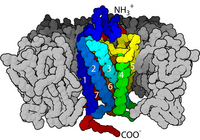
Photo from wikipedia
Throughout their lifetimes, all cells experience force. These forces are sensed by cell surface adhesion receptors, such as the cadherins and integrins. Much attention has focused on identifying how these… Click to show full abstract
Throughout their lifetimes, all cells experience force. These forces are sensed by cell surface adhesion receptors, such as the cadherins and integrins. Much attention has focused on identifying how these adhesion receptors transmit force. In contrast, less is known regarding how these force-activated pathways are integrated with other cellular processes. In this review, we describe how cadherins and integrins transmit force, and discuss how these adhesion receptors are linked to cell metabolism. We focus on understanding this connection by highlighting how the cadherins and integrins interact with a master regulator of energy homeostasis, AMP-activated protein kinase (AMPK) and its upstream activator, Liver Kinase B1 (LKB1). We consider why there is a need for force transmission to be coupled to metabolism and highlight the major unanswered questions in the field.
Journal Title: Current opinion in cell biology
Year Published: 2018
Link to full text (if available)
Share on Social Media: Sign Up to like & get
recommendations!